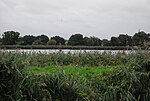Happy Man Tree
2020 in London2020s individual tree deathsHackney, LondonIndividual plane treesIndividual trees in England

The Happy Man Tree was a plane tree in the Woodberry Down area of Hackney, London, which was awarded Tree of The Year for 2020 by the Woodland Trust. The tree was the subject of a dispute between Berkeley Homes and members of the local community over plans for it to be cut down to enable new home construction. A petition to save the tree with 22,000 signatures was delivered to the Mayor of Hackney in June 2020, with the high court granting an injunction to stop protesters blocking the demolition work granted two days later. The tree was ultimately cut down in January 2021.
Excerpt from the Wikipedia article Happy Man Tree (License: CC BY-SA 3.0, Authors, Images).Happy Man Tree
Woodberry Grove, London Stamford Hill (London Borough of Hackney)
Geographical coordinates (GPS) Address Nearby Places Show on map
Geographical coordinates (GPS)
| Latitude | Longitude |
|---|---|
| N 51.572083333333 ° | E -0.090166666666667 ° |
Address
The Happy Man
Woodberry Grove 89
N4 2SB London, Stamford Hill (London Borough of Hackney)
England, United Kingdom
Open on Google Maps






